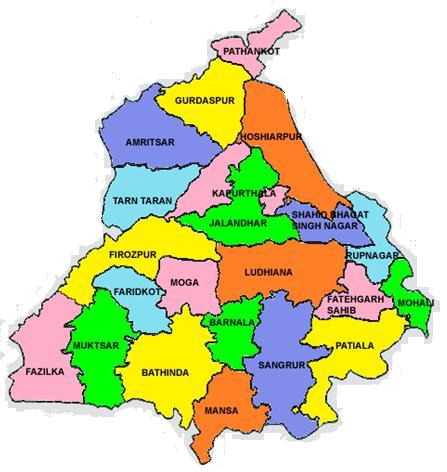|
State Profile
Punjab, state
of
India, located in the
northwestern part of the
subcontinent. It is bounded by
the Indian states of Jammu and
Kashmir to the north, Himachal
Pradesh to the northeast,
Haryana to the south and
southeast, and Rajasthan to the
southwest and by the country of
Pakistan to the west. Punjab in
its present form came into
existence on November 1, 1966,
when most of its predominantly
Hindi-speaking areas were
separated to form the new state
of Haryana. The city of
Chandigarh, within the
Chandigarh union territory, is
the joint capital of Punjab and
Haryana.
The word Punjab is a compound of
two Persian words, panj
(“five”) and āb
(“water”), thus signifying the
land of five waters, or rivers
(the Beas, Chenab, Jhelum, Ravi,
and Sutlej). As applied to the
present Indian state of Punjab,
however, it is a misnomer: since
the partition of India in 1947,
only two of these rivers, the
Sutlej and the Beas, lie within
Punjab’s territory, while the
Ravi flows only along part of
its western border. Area 19,445
square miles (50,362 square km).
Pop. (2011) 27,704,236.
Punjab is widely acknowledged as
the "Granary of India".
Since the land is fertile and
its mainly free from physical
undulation, agriculture is the
mainstay of the State. Major
crops include wheat, rice,
sugarcane, cotton and oilseeds.
Punjab is the second largest
producer of wheat in India.
Industrial growth in
recent years has been a major
contributor to the state's
economy. The excellent
infrastructural framework namely
connectivity by road, rail and
air has paved way for industrial
prosperity. The prime industries
are textile, food processing,
sports goods, engineering goods,
chemicals, handicrafts. |
|
 |
|
|
|
State Capital
|
Chandigarh
|
|
Area (Sq.km) |
50,362 sq.km |
|
Population (Census 2011)
|
2,77,04,236 |
|
Population Density (Sq.Km) |
550 |
|
Population Size (Males) |
1,46,34,819 |
|
Population Size
(Females) |
1,30,69,417 |
|
Population Size (Rural) |
1,73,16,800 |
|
Population Size (Urban) |
1,03,87,436 |
|
Population Size (Rural
Males) |
90,86,466 |
|
Population Size (Rural
Females) |
82,30,334 |
|
Population Size (Urban
Males) |
55,48,353 |
|
Population Size (Urban
Females) |
48,39,083 |
|
Sex Ratio (Females per
1000 males)
|
893 |
|
Sex Ratio (Rural) |
906 |
|
Sex Ratio (Urban) |
872 |
|
Population size, 0-6 yrs |
29,41,570 |
|
Population size, 0-6 yrs
(Males) |
15,93,262 |
|
Population size, 0-6 yrs
(Females) |
13,48,308 |
|
Sex Ratio, 0-6 yrs
(Females per 1000 males) |
846 |
|
Sex Ratio, 0-6 yrs
(Rural) |
843 |
|
Sex Ratio, 0-6 yrs
(Urban) |
851 |
|
No. of Districts
|
22
(Amritsar, Ajitgarh (Mohali),
Barnala, Bathinda,
Faridkot, Fatehgarh
Sahib, Fazilka,
Ferozepur, Gurdaspur,
Hosiarpur, Jalandhar,
Kapurthala, Ludhiana,
Mansa, Moga, Pathankot,
Patiala, Roopnagar,
shaheed bhagat singh
Nagar, Sangrur, Tarn
Taran. |
|
Important Rivers
|
Ravi, Beas, Satluj |
|
Prominent tourist
destinations
|
Golden temple, Wagah Border,
Anandpur Sahib,
Jallianwala Bagh |
|
International airport |
Raja Sansi international
Airport, Amritsar |
|
Literacy Rate (2011
Census) |
76.7% |
|
Sex Ratio (2011 Census) |
893 |
|
key Industries
|
Agro and food processing,
Beverages, IT and
knowledge, Textiles,
Hoisery, Wollen garments
Tourism, Handicrafts,
Automobile, Chemicals,
Metal and Light
Engineering.
|
|
Main Industrial Cities |
Ludhiana, Jalandhar, Amritsar
and Ajitgarh (Mohali)
|
|
|
|
|
|